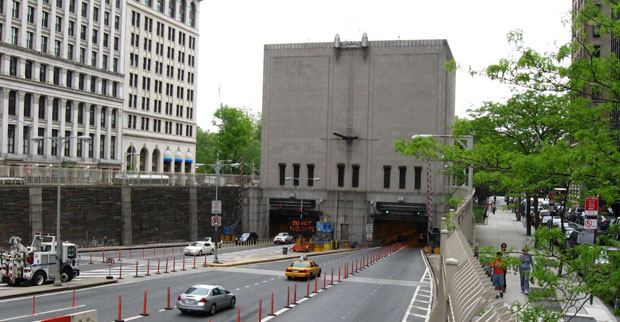The Brooklyn-Battery Tunnel in New York City, recently renamed the Hugh L. Carey Tunnel by legislators of New York, is the longest continuous tunnel in North America to carry underwater vehicular traffic. The tunnel consists of two tubes and four traffic lanes that carry the traffic of the unmarked Interstate 478 designation under the East River and below Governors Island, connecting the Borough of Brooklyn to the Borough of Manhattan. This tunnel is 9,117 feet long and extends from the location of a former artillery battery in South Manhattan to the Red Hook neighborhood in Brooklyn. It has a vertical clearance of 12 feet and 1 inch for vehicular traffic.
Plans for building the tunnel were made in the 1930s, when an urgent need for an additional traffic connection between the boroughs arose. At first, the New York City Planning Commission was unsure whether a tunnel would be more beneficial for vehicular access or if a bridge could better accommodate the connecting traffic.

Looking south from pedestrian overpass on a cloudy afternoon at Brooklyn Battery Tunnel Manhattan entrance.
During the original planning phase for the construction of the Brooklyn-Battery Tunnel, proposals were made to include a crossing that would link the West Side Highway in Manhattan to the Gowanus Expressway and the Belt Parkway in Brooklyn. The proposed Brooklyn-Battery Bridge was intended to better accommodate the steadily increasing flow of traffic utilizing New York bridges on a daily basis. However, the bridge proposal was heavily opposed by several New York City business and political establishments. The proposal was finally declined after the Secretary of War during the Roosevelt Administration declared that the location of the future bridge would not only impair access to the nearby Navy Yard but also be a vulnerable landmark during a potential wartime attack.
In October of 1940, the New York City Tunnel Authority began the construction of the Brooklyn-Battery Tunnel after the tunnel design by civil engineer Ole Singstad was accepted. However, with the impending economic depression resulting from World War II, the tunnel construction experienced a significant delay that stretched on for over three years. Following a merger forming the Triborough Bridge and Tunnel Authority, tunnel construction was restarted and finally completed nearly a decade after breaking ground. The tunnel officially opened on May 25, 1950 as a toll road and initially carried New York State Route 27A. The total construction of the Brooklyn-Battery Tunnel cost an estimated $90 million.
The creation of the Brooklyn-Battery Tunnel was a welcome addition to the New York City tunnel system. During its first year of operation, the tunnel carried more than 41,000 vehicles each day. Within its first 15 years of operation, the Brooklyn-Battery Tunnel was one of two tunnel systems in New York City that helped generate almost one-third of the Triborough Bridge and Tunnel Authority’s annual revenue. Today, the tunnel may be used by upwards of 60,000 vehicles per day.
In December 2010, the tunnel’s toll was increased to $6.50 per direction for each two-axle passenger vehicle and $2.75 per direction for motorcycles. Travelers in need of frequent tunnel access for transportation between the Borough of Brooklyn and the Borough of Manhattan are able to save $1.70 and $0.66 respectively by accessing the toll road with an E-Z Pass. The tunnel conveniently services communities within South Brooklyn, including the districts of Red Hook, Carroll Gardens, Cobble Hill, Columbia Terrace, and Boerum Hills, and leads to areas within the Borough of Manhattan, such as the South Street Seaport, Battery Park City, Wall Street, the World Financial Center, and the World Trade Center site.
Currently the tunnel is maintained by the MTA Bridges and Tunnels division and has approximately 45,337 vehicles traveling through it daily. The tunnel also carries 26 express bus routes operated by both MTA New York City Transit and the MTA Bus Company to offer connecting transportation for Manhattan, Brooklyn, and Staten Island. The Brooklyn-Battery Tunnel has four ventilation buildings responsible for air exchange within the tunnel. Two ventilation buildings are located in Manhattan, one in Brooklyn, and another off Governors Island. These ventilation buildings ensure that the tunnel’s air supply is changed every 90 seconds.
New York State legislators proposed renaming the Brooklyn-Battery Tunnel after former Governor Hugh Carey in December 2010, and on October 22, 2012, the tunnel’s designation was officially changed to Hugh L. Carey Tunnel.
In the past, the tunnel has been subject to closures during emergencies. After the attacks on the World Trade Center on September 11, 2001, the Brooklyn-Battery Tunnel remained closed to all traffic for over one month as post-attack rehabilitation became necessary. Only emergency vehicles were permitted to access the tunnel at that time. The tunnel was also closed to traffic on October 29, 2012, one week after it was renamed, because of the severe storm surge anticipated as a result of Hurricane Sandy. The hurricane flooded the Hugh L. Carey Tunnel with almost 90 million gallons of water. After the removal process, authorities were able to reopen the tunnel for limited vehicular traffic on November 13, 2012. Sandy’s storm surge left the Hugh L. Carey Tunnel with significant water damage requiring extensive repair work.




